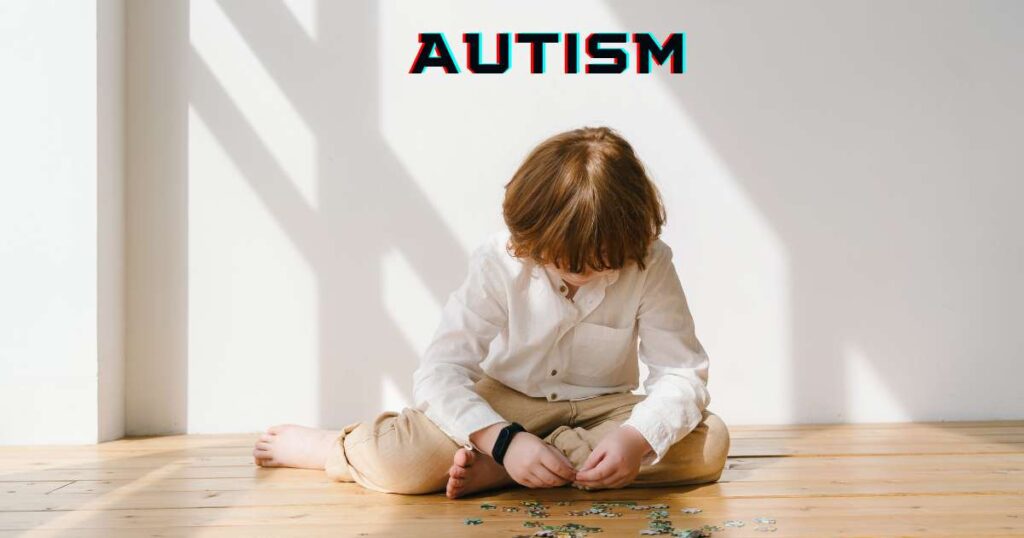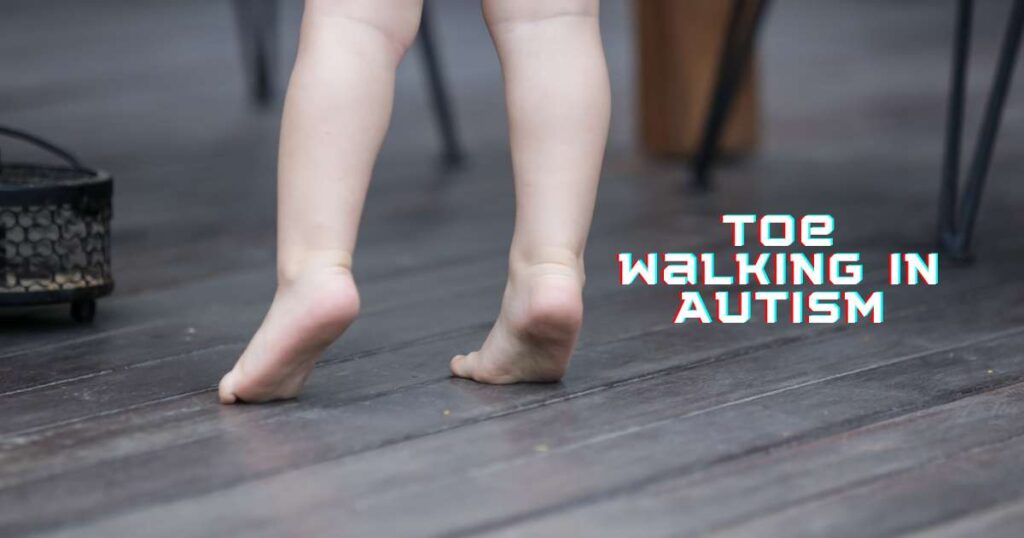Introduction
Children often toe-walk without their heels touching the ground. Toe walking is more common and persistent in people with autism spectrum disorder (ASD). How to stop toe walking in autism? Here are the different aspects of this question
ASD, a complex neurodevelopmental disorder, causes social, communication, and repetitive behavior issues. Toe walking is more common in ASD children than in typically developing children, according to research. About 60% of autistic children persistently toe walk, according to studies.
Several factors cause autism-related toe walking. ASD children may have sensory issues like trouble processing foot sensory information, which can alter gait. Autism can be accompanied by idiopathic toe walking, cerebral palsy, or muscular dystrophy.
Autism-related toe walking can affect motor skills, balance, and coordination, so it must be addressed. It can also cause muscular imbalances, limited foot and ankle motion, and impair their ability to exercise or walk normally.
In the following sections, we will discuss the causes of toe walking in autism and ways to stop it and promote normal walking patterns. Understanding and treating toe walking can improve autistic individuals’ mobility and function.

Autistic children usually have narrow choices about play, communication, clothing
How to Stop Toe Walking in Autism
ASD kids often toe walk. Instead of using the whole foot, walk on the balls. In children with autism, toe walking can be caused by idiopathic conditions, but healthcare professionals must address it. Autistic toe-walking treatment often includes physical therapy, occupational therapy, and medicine. Children can improve their gait, range of motion, and muscle strength with physical therapy. Occupational therapists manage sensory issues and improve balance and body awareness. Medical professionals may recommend leg braces or manual calf muscle stretches for tight calf muscles. Healthcare professionals can improve autistic individuals’ walking patterns and motor development with these treatments. Below are the best strategies for “How to stop toe walking in autism.”
Strengthening Exercises for Calf and Foot Muscles
ASD children often walk with toes, also known as idiopathic toe walking. Neurological conditions like cerebral palsy or muscular dystrophy can cause persistent toe walking, but it can also be idiopathic in children with no known medical conditions.
Physical therapy is essential for autism toe walking. Calf and foot strengthening exercises improve gait and range of motion. These exercises build lower-extremity muscle strength and reduce tightness.
For children with autism and toe walking, physical therapy can include strengthening exercises like:
1. Toe grips: Have the child pick up marbles or washcloths with their toes. Foot muscles and positioning are worked in this exercise.
2. Encourage the child to balance foam blocks or bean bags on their feet. It strengthens foot muscles and improves balance and coordination.
3. Scooterboard activities: Have the children push themselves forward or backward on a scooterboard. This exercise works the calves and improves footwork.
4. Slide walking: Have the child walk flat-footed up a slide. Calf and foot muscles are strengthened and gait abnormalities improved with this activity.
5. Wall chair poses: Help the child sit with their back against a wall and knees bent like a chair. Calf muscles are toned and strengthened by this exercise.
These strengthening exercises and other medically recommended interventions can help address toe walking in children with autism in physical therapy. Consult a physical or occupational therapist for a customized exercise plan for your child.
Balance and Proprioception Activities
ASD children need balance and proprioception activities to toe walk. These activities improve balance and address ASD sensory issues.
A variety of balance activities can help the child walk with balance. The child can balance on a wobbleboard using their core and legs. Walk across a balance beam or step on different height stones to improve balance and coordination.
Benefits include proprioception exercises, which increase body awareness of position and movement. Proprioceptive feedback can be improved by standing on an air cushion or bouncing on a therapy ball.
These balance and proprioception activities in physical therapy can help autistic and toe-walking children gain body awareness and stability. These activities can supplement strengthening exercises and correct tiptoe gait abnormalities.
Orthotics or Braces to Control Foot Positioning
ASD children need orthotics and braces to control foot positioning and stop toe walking. These devices improve walking patterns and correct gait abnormalities.
Children who walk on their toes often wear rigid carbon foot plates or ankle-foot orthoses (AFOs). These devices support and stabilize the foot in a natural, flat position. Limited plantar flexion discourages toe walking and promotes heel-to-toe gait.
In addition to orthotics, other methods can correct foot position and discourage toe walking. High-top shoes stabilize ankles and reduce plantar flexion. Shoes can be fitted with heel wedges for extra support and foot alignment. Shoe inserts can correct muscle imbalances and tightness that cause toe walking.
Physical therapists and orthotists should prescribe and fit orthotics and braces. These professionals can evaluate the child’s needs and suggest the best foot positioning.
Toe Walking in Autism
ASD children have more often and persistent toe walking. Up to 60% of autistic children will toe walk, according to research. Sensory issues and medical conditions like idiopathic toe walking, cerebral palsy, and muscular dystrophy can cause this behavior. Toe walking in autistic people can affect their motor skills, balance, coordination, and ability to walk normally.
Why Do Autistic People Walk On Their Toes?
ASD individuals often walk on their toes. ASD individuals’ neurological and sensory issues may explain this atypical walking pattern.
Autism can cause toe walking due to vestibular dysfunction. ASD can impair this balance and spatial orientation system. Toe walking can result from vestibular system dysfunction, which impairs coordination, balance, and body awareness.
Autism-related postural instability and gaze issues can also cause toe walking. Toe walking is a compensation for these challenges, which impair posture and coordination.
Gait dysfunction, such as abnormal walking patterns, can also cause toe walking in autism. Autistic people may have muscle weakness, tight calf muscles, or other muscular disorders that disrupt their gait cycle.
Understanding why ASD individuals toe walk is essential for developing effective interventions. Physical, occupational, and medical interventions like leg braces can improve walking patterns, range of motion, and muscle strength. By treating the causes and providing targeted therapies, autistic people can overcome toe walking and improve their mobility and quality of life.
Assessing and Diagnosing Toe Walking in Autism
Assessing and diagnosing toe walking in autism requires a thorough evaluation. This process relies on physical and occupational therapists. They will thoroughly examine the individual to determine medical history, developmental delays, family history of toe walking or developmental disorders, and sensory issues. The assessment will also evaluate gait, range of motion, muscle tone, and physical abilities. Neurological assessments or imaging studies may be ordered to rule out neurological conditions. After the evaluation, idiopathic toe walking—toe walking without a medical cause—can be diagnosed. This diagnosis will help create a personalized treatment plan.
Physical Examination
Toe walking in ASD requires a thorough physical exam. This exam helps diagnose and treat idiopathic toe walking.
A person’s walking pattern is examined first. Look for persistent toe walking, where the person walks on tiptoes without heels. Calf and foot muscle tightness may also occur.
Toe walking in autism may be linked to neurological issues, so gait abnormalities should be checked. Walking patterns can be analyzed using gait analysis to determine the range of motion and gait cycle.
Electromyography is another useful physical exam tool. This test measures muscle electrical activity to detect tightness and neurological issues.
Physical and occupational therapists can assess muscle tone, strength, and neurological involvement by performing a thorough physical exam. Toe walking in autism can be addressed with physical exercises, leg braces, and other medical interventions based on this information.
Early detection, intervention, and a multidisciplinary approach involving doctors and therapists can improve walking patterns in children with ASD.
Medical Conditions
Autism may be linked to several medical conditions that cause persistent toe walking. These include cerebral palsy and GLUT1 Deficiency Syndrome.
Reduced plantarflexion can cause toe walking in cerebral palsy. In plantarflexion, the foot and ankle descend and point the toes. Toe walking is a compensatory gait pattern for cerebral palsy individuals with reduced plantarflexion.
Toe walking is common in GLUT1 Deficiency Syndrome. This rare neurological disorder affects glucose entry into the brain, causing developmental delay, seizures, and toe walking.
Understanding the medical conditions that may cause persistent toe walking in autism is essential for developing effective interventions and treatments. Physical and occupational therapy can improve gait and mobility in cerebral palsy and GLUT1 Deficiency Syndrome individuals by targeting underlying causes. Medical professionals must thoroughly evaluate and consider these medical conditions to provide the best interventions for persistent toe walking in autism spectrum disorder.
Gait Pattern Analysis
Gait pattern analysis is essential for diagnosing toe walking in autism. A thorough gait analysis can reveal the person’s walking patterns and abnormalities.
A physical therapist or occupational therapist will observe the person’s gait. They will look for abnormalities like excessive toe walking or no heel-to-toe movement.
The professional will evaluate muscle tone, range of motion, and strength. Tightness or weakness in the calf muscles can cause persistent toe walking, so they will check. Understanding the gait pattern requires evaluating the entire foot, including muscles and joints.
Consider sensory issues and developmental delays when analyzing gait patterns in autistic children. Sensory processing issues can affect how autistic people perceive and respond to tactile feedback, affecting walking patterns. Developmental delays may also cause gait abnormalities in autistic children.
In conclusion, gait pattern analysis helps diagnose and understand autism toe walking. Professionals can target and treat gait abnormalities in this population by assessing walking patterns, muscle tone, range of motion, sensory issues, and developmental delays.
Range of Motion Assessment
A range of motion assessment can assess the child’s calf and foot flexibility. This assessment determines muscle tightness or limitations that may cause persistent toe walking.
Start the range of motion assessment by having the child sit or lie back comfortably. Hold one foot with the knee straight and gently stretch the Achilles heel cord for 1 minute. This stretch tests calf flexibility.
Besides sitting or lying, having the child stand or walk up an incline can help during the assessment. This movement increases the range of motion and better assesses calf and foot muscle flexibility.
During range of motion testing, look for muscle tightness or limitations. This information can help create a customized treatment plan.
Physical and occupational therapists can assess a child’s calf and foot muscle flexibility using a range of motion assessment. Identifying tightness or limitations can help develop targeted interventions for persistent toe walking in autistic children.
Sensory Processing Evaluation
Sensory processing evaluation is essential to understanding autism’s toe-walking sensory challenges. These evaluations identify sensory processing issues like tactile defensiveness and vestibular dysfunction that may cause toe walking.
Autism sensory processing assessments require a variety of tools. The Sensory Processing Measure, which measures everyday sensory responses, is widely used. Another tool for assessing sensory processing patterns and identifying sensory challenges is the Sensory Profile.
During a sensory processing evaluation, the individual’s responses to touch, movement, and auditory input are recorded. This assessment illuminates sensory processing patterns and issues.
Reducing toe walking in autism requires addressing sensory issues. Identifying tactile defensiveness can help develop touch desensitization and tolerance strategies. Vestibular dysfunction evaluation can also guide balance and body awareness interventions.
Understanding and addressing sensory processing issues can help autistic people who walk on their toes find sensory alternatives. Sensory toys, weighted blankets, and movement breaks can reduce toe walking and encourage normal walking.
Developmental Screening Tests
Developmental screening tests help diagnose autism-related toe walking. These tests evaluate an individual’s development and can identify developmental delays or disorders that may cause the gait abnormality.
Healthcare professionals can assess gross motor skills, muscle tone, and sensory processing through developmental screening tests. These tests can reveal the individual’s development and identify any issues that may be causing toe walking.
A screening test may show calf muscle tone or weakness, which can affect walking. These tests can also detect sensory processing issues that cause toe walking. Autism-related sensory issues like touch sensitivity, balance, and body awareness can affect gait patterns.
Screening tests can identify developmental delays or disorders, allowing healthcare professionals to tailor interventions. Working with physical therapists, occupational therapists, or other medical professionals to implement appropriate interventions like physical exercises, sensory integration, or leg braces may be necessary.
Overall, developmental screening tests are essential for understanding autism-related toe walking and developing effective interventions to promote more typical walking patterns.
Conclusion
This article reviewed how to stop toe walking in autism. It is concluded that occupational and physical therapy to improve sensory integration and muscle flexibility, behavioral interventions like ABA therapy to modify behavior, and orthotic devices or proper footwear may help autistic people walk. Early intervention and personalized strategies, developed in consultation with healthcare professionals, can be effective.
FAQs
Here are a few FAQs about “How to stop toe walking in autism”
Do autistic kids grow out of toe walking?
Autistic children may outgrow toe walking, but others may continue into adolescence or adulthood. It varies by person. Autistic children can benefit from early intervention and therapy for toe walking.
Is tip toe walking ADHD or autism?
Toe walking can be linked to ADHD and autism, but not definitively. Toe walking can occur for many reasons, so it’s important to consider a wider range of symptoms and evaluations to diagnose ADHD, autism, or another condition.
How common is toe walking in autism?
Up to 20-30% of autistic children may toe walk. Toe walking can happen in children without autism, and not all autistic children do it.







